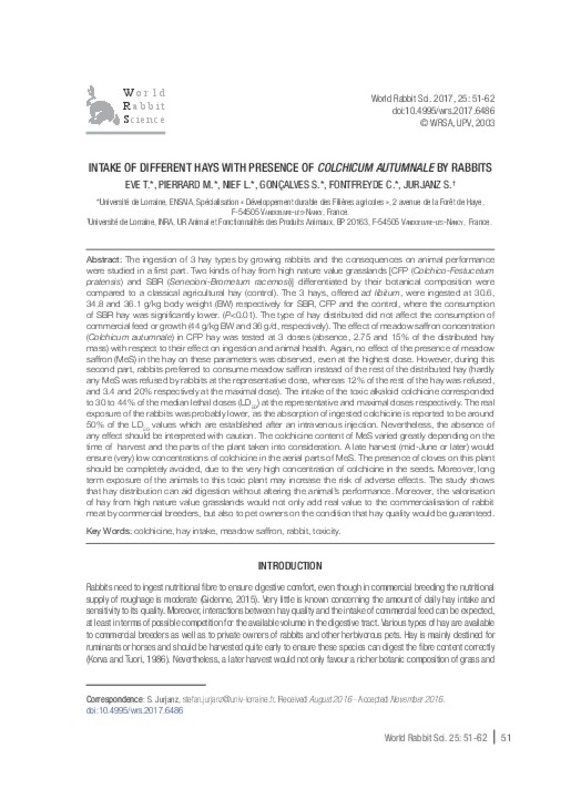JavaScript is disabled for your browser. Some features of this site may not work without it.
Buscar en RiuNet
Listar
Mi cuenta
Estadísticas
Ayuda RiuNet
Admin. UPV
Intake of different hays with presence of Colchicum autumnale by rabbits
Mostrar el registro sencillo del ítem
Ficheros en el ítem
| dc.contributor.author | Eve, T.
|
es_ES |
| dc.contributor.author | Pierrard, M.
|
es_ES |
| dc.contributor.author | Nief, L.
|
es_ES |
| dc.contributor.author | Gonçalves, S.
|
es_ES |
| dc.contributor.author | Fontfreyde, C.
|
es_ES |
| dc.contributor.author | Jurjanz, S.
|
|
| dc.date.accessioned | 2017-04-03T10:19:40Z | |
| dc.date.available | 2017-04-03T10:19:40Z | |
| dc.date.issued | 2017-03-03 | |
| dc.identifier.issn | 1257-5011 | |
| dc.identifier.uri | http://hdl.handle.net/10251/79358 | |
| dc.description.abstract | [EN] The ingestion of 3 hay types by growing rabbits and the consequences on animal performance were studied in a first part. Two kinds of hay from high nature value grasslands [CFP (Colchico-Festucetum pratensis) and SBR (Senecioni-Brometum racemosi)] differentiated by their botanical composition were compared to a classical agricultural hay (control). The 3 hays, offered ad libitum, were ingested at 30.6, 34.8 and 36.1 g/kg body weight (BW) respectively for SBR, CFP and the control, where the consumption of SBR hay was significantly lower. (P<0.01). The type of hay distributed did not affect the consumption of commercial feed or growth (44 g/kg BW and 36 g/d, respectively). The effect of meadow saffron concentration (Colchicum autumnale) in CFP hay was tested at 3 doses (absence, 2.75 and 15% of the distributed hay mass) with respect to their effect on ingestion and animal health. Again, no effect of the presence of meadow saffron (MeS) in the hay on these parameters was observed, even at the highest dose. However, during this second part, rabbits preferred to consume meadow saffron instead of the rest of the distributed hay (hardly any MeS was refused by rabbits at the representative dose, whereas 12% of the rest of the hay was refused, and 3.4 and 20% respectively at the maximal dose). The intake of the toxic alkaloid colchicine corresponded to 30 to 44% of the median lethal doses (LD50) at the representative and maximal doses respectively. The real exposure of the rabbits was probably lower, as the absorption of ingested colchicine is reported to be around 50% of the LD50 values which are established after an intravenous injection. Nevertheless, the absence of any effect should be interpreted with caution. The colchicine content of MeS varied greatly depending on the time of harvest and the parts of the plant taken into consideration. A late harvest (mid-June or later) would ensure (very) low concentrations of colchicine in the aerial parts of MeS. The presence of cloves on this plant should be completely avoided, due to the very high concentration of colchicine in the seeds. Moreover, long term exposure of the animals to this toxic plant may increase the risk of adverse effects. The study shows that hay distribution can aid digestion without altering the animal’s performance. Moreover, the valorisation of hay from high nature value grasslands would not only add real value to the commercialisation of rabbit meat by commercial breeders, but also to pet owners on the condition that hay quality would be guaranteed. | es_ES |
| dc.description.sponsorship | The authors thank PNRL for providing the studied hay types and the specialization staff of ENSAIA for their technical support. Furthermore, we warmly thank Thierry Gidenne from INRA Toulouse and Sylvain Plantureux from INRA Nancy for their scientific coaching for rabbit and grassland sciences, respectively | |
| dc.language | Inglés | es_ES |
| dc.publisher | Universitat Politècnica de València | |
| dc.relation.ispartof | World Rabbit Science | |
| dc.rights | Reserva de todos los derechos | es_ES |
| dc.subject | Colchine | es_ES |
| dc.subject | Hay intake | es_ES |
| dc.subject | Meadow saffron | es_ES |
| dc.subject | Rabbit | es_ES |
| dc.subject | Toxicity | es_ES |
| dc.title | Intake of different hays with presence of Colchicum autumnale by rabbits | es_ES |
| dc.type | Artículo | es_ES |
| dc.date.updated | 2017-04-03T09:52:13Z | |
| dc.identifier.doi | 10.4995/wrs.2017.6486 | |
| dc.rights.accessRights | Abierto | es_ES |
| dc.description.bibliographicCitation | Eve, T.; Pierrard, M.; Nief, L.; Gonçalves, S.; Fontfreyde, C.; Jurjanz, S. (2017). Intake of different hays with presence of Colchicum autumnale by rabbits. World Rabbit Science. 25(1):51-62. https://doi.org/10.4995/wrs.2017.6486 | es_ES |
| dc.description.accrualMethod | SWORD | es_ES |
| dc.relation.publisherversion | https://doi.org/10.4995/wrs.2017.6486 | es_ES |
| dc.description.upvformatpinicio | 51 | es_ES |
| dc.description.upvformatpfin | 62 | es_ES |
| dc.type.version | info:eu-repo/semantics/publishedVersion | es_ES |
| dc.description.volume | 25 | |
| dc.description.issue | 1 | |
| dc.identifier.eissn | 1989-8886 |








